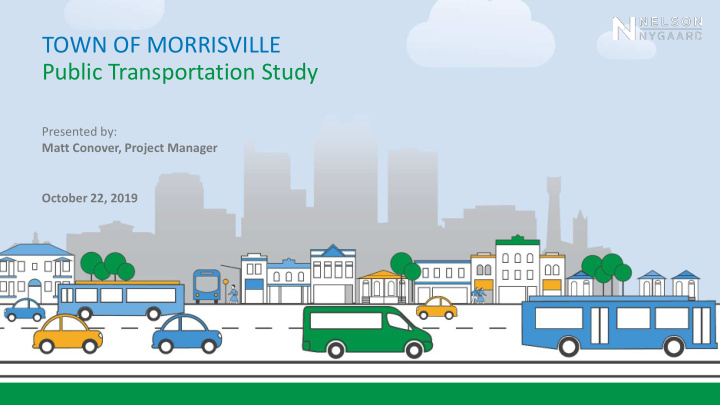



TOWN OF MORRISVILLE Public Transportation Study Presented by: Matt Conover, Project Manager October 22, 2019
AGENDA DA 01 | Study Recap 02 | Final Recommendation
Study Recap
PUBLIC TRANSPORTATION STUDY Existing Conditions Outreach Service Scenarios Final Recommendation
Trip Generators • Activity centers are often centralized locations • Everyone is trying to access • Many-to-one travel • Represent a “strong anchor” • Some are 8 AM to 5 PM locations while many are all day • Residential areas are more dispersed • One-to-many travel 5
Propensity • Density is the largest factor • Employment generates the largest draw • Mixed use generates higher levels of demand • Multi-family residential areas have more demand than single family units
Travel Flows • Strong flows to/from employment centers • Grace Park • Park West Village • Perimeter Park • RTP • Davis Drive/High House Road Intersection • Lighter flows to/from: • Residential areas • Airport • Wake Tech RTP 7
Outreach • Open House – Mar. 25 th • Town Council Meeting/Planning Zoning Board Work Session – Mar. 25 th • Music in the Park – May 16 th • Morrisville Senior Center – May 17 th • HSNC Health Fair – May 18 th • SpringFest – May 18 th • Wake Tech RTP – May 21 st • Open House – Jun. 24 th • Town Council Meeting/Planning Zoning Board Work Session – Jun. 24 th 8
Fixed Schedule Shuttle 198 Community Feedback Serve Job Centers 157 Serve Residential Centers 147 Serve Older Adults 93 Design Your Own Transit system Uber Lyft Partnership 85 • March 25 th – June 3 rd On-Demand Shared Ride Shuttle 79 Serve Students 75 • 240 Responses 0 50 100 150 200 250 Operate Service on Weekdays 194 Operate Peak Hour Only Service 107 Operate Saturday Service 100 If local transit service that met your needs was available in Morrisville how often would you utilize the service? Operate Midday Service 70 Seven Operate Evening Service 55 days a Never week 9% Operate Sunday Service 49 8% Operate Early Morning Service 18 Five days a week One day a week or 21% 0 50 100 150 200 250 less 24% Connect to Regional Services 197 Improve Walking Connections to Potential Bus Two or three days a week 164 38% Stops Passenger Shelters and Amenities 154 0 50 100 150 200 250
Stakeholder Feedback • Morrisville Town Council • CAMPO • GoCary • GoRaleigh • GoTriangle
Public Transit Organizational Chart Service Methods Four Primary Methods In-House Operation Turnkey Contract Transportation Network Company Contract Existing Provider Partnership 11
Service Modes Three primary options Fixed Route Demand Response Smart Shuttle 12
Fixed Route • Most familiar • Fixed path with a set schedule • Serves important corridors • Links key destinations • Works best when focused on a specific market with a consistent customer
Demand Response • Covers entire town • Front door service • No consistent schedule • No consistent path • Lower productivity • Works best for occasional purposes or standing reservations
Smart Shuttle • Hybrid of fixed-route and demand response services • Only serves designated nodes • Highly adaptable • Matches service to demand • Somewhat predictable • Can lead to fixed-route service • Works best for daily consistent purposes
02 Final Recommendation
Mode Recommendation Operating Capital Use of Coverage Start Up Scalable ADA Cost Cost Technology Smart High Low Low Quick High Yes Included Recommended Shuttle Fixed Not Low Moderate High Slow Moderate No Extra Route Recommended Not Demand High High Low Quick Moderate No Included Recommended Response
Method Recommendation Operating Town Town Start Up Cost Oversight Control Partnership Low Low Moderate Quick Recommended Not In House High High High Slow Recommended Not Turnkey Moderate Moderate Moderate Moderate Recommended Not TNC Low High Moderate Quick Recommended
Smart Shuttle Recommendation
Possible Recommendations For Marketing New Service Build Cultivate Develop Inform Support Awareness Identity Acquire Develop a Develop a Keep all functional, brochure website branding and attractive marketing transit swag Leave Develop a consistent materials service area Participate in with map Build community stakeholder compelling events organizations Develop a social media ride guide presence Conduct a Meet with marketing employers Reach out to Keep vehicles campaign existing bus clean and Establish a riders branded Produce travel annual training Keep nodes briefing program clean and report branded
Measuring Success Service Standards • Monitor service for needed changes Design principals • Simple is better than complicated • Operate along a direct path • Serve well defined markets • Focus around landmarks • Coordinate with other service providers Service guidelines • 1.5 passengers per revenue hour • $30 operating cost per passenger • <30 minute average wait times • Ramp up period to reach full potential • year 1: 0%/ year 2: 0%/ year 3: 50%/ year 4: 75%
Avoiding Pitfalls • Market, market, market • Invest in the capital early and maintain it • Grow the service according to the standards • Avoid bad service – “if it would not be done in a car, don’t do it in a bus” • Stick to the plan!
Recommend
More recommend